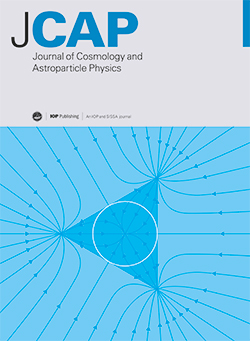On the dark matter origin of an LDMX signal
IF 5.9
2区 物理与天体物理
Q1 ASTRONOMY & ASTROPHYSICS
Journal of Cosmology and Astroparticle Physics
Pub Date : 2025-07-08
DOI:10.1088/1475-7516/2025/07/020
引用次数: 0
Abstract
Fixed target experiments where beam electrons are focused upon a thin target have shown great potential for probing new physics, including the sub-GeV dark matter (DM) paradigm. However, a signal in future experiments such as the light dark matter experiment (LDMX) would require an independent validation to assert its DM origin. To this end, we propose to combine LDMX and next generation DM direct detection (DD) data in a four-step analysis strategy, which we here illustrate with Monte Carlo simulations. In the first step, the hypothetical LDMX signal (i.e. an excess in the final state electron energy and transverse momentum distributions) is recorded. In the second step, a DM DD experiment operates with increasing exposure to test the DM origin of the LDMX signal. Here, LDMX and DD data are simulated. In the third step, a posterior probability density function (pdf) for the DM model parameters is extracted from the DD data, and used to predict the electron recoil energy and transverse momentum distributions at LDMX. In the last step, predicted and recorded electron recoil energy and transverse momentum distributions are compared in a chi-square test. We present the results of this comparison in terms of a threshold exposure that a DD experiment has to operate with to assert whether predicted and recorded distributions can be statistically dependent. We find that this threshold exposure grows with the DM particle mass, mχ. It varies from 0.0013 kg-year for a DM mass of mχ = 4 MeV to 1.9 kg-year for mχ = 25 MeV, which is or will soon be within reach.关于LDMX信号的暗物质起源
固定目标实验将电子束聚焦在一个薄目标上,在探索新物理学方面显示出巨大的潜力,包括亚gev暗物质(DM)范式。然而,在未来的实验中,如光暗物质实验(LDMX)中的信号将需要一个独立的验证来断言它的DM起源。为此,我们建议将LDMX和下一代DM直接检测(DD)数据结合在一个四步分析策略中,我们在这里用蒙特卡罗模拟来说明。第一步,记录假设的LDMX信号(即终态电子能量和横向动量分布的过剩)。在第二步中,DM DD实验通过增加暴露来测试LDMX信号的DM来源。这里对LDMX和DD数据进行了模拟。第三步,从DD数据中提取DM模型参数的后验概率密度函数(pdf),并用于预测LDMX的电子反冲能量和横向动量分布。最后一步,用卡方检验比较了预测值和记录值的电子反冲能和横向动量分布。我们在阈值暴露方面提出了这种比较的结果,DD实验必须使用阈值暴露来断言预测和记录的分布是否可以在统计上依赖。我们发现这个阈值暴露随着DM粒子质量mχ的增加而增加。从DM质量为mχ = 4 MeV的0.0013 kg-年到mχ = 25 MeV的1.9 kg-年不等,这是或即将达到的。
本文章由计算机程序翻译,如有差异,请以英文原文为准。
求助全文
约1分钟内获得全文
求助全文
来源期刊

Journal of Cosmology and Astroparticle Physics
地学天文-天文与天体物理
CiteScore
10.20
自引率
23.40%
发文量
632
审稿时长
1 months
期刊介绍:
Journal of Cosmology and Astroparticle Physics (JCAP) encompasses theoretical, observational and experimental areas as well as computation and simulation. The journal covers the latest developments in the theory of all fundamental interactions and their cosmological implications (e.g. M-theory and cosmology, brane cosmology). JCAP''s coverage also includes topics such as formation, dynamics and clustering of galaxies, pre-galactic star formation, x-ray astronomy, radio astronomy, gravitational lensing, active galactic nuclei, intergalactic and interstellar matter.
 求助内容:
求助内容: 应助结果提醒方式:
应助结果提醒方式:


